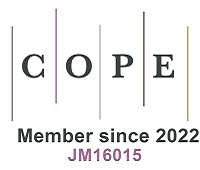Grain engineering of high energy density BaTiO3 thick films integrated on Si
Abstract
Ferroelectric (FE) ceramics with a large relative dielectric permittivity and a high dielectric strength have the potential to store or supply electricity of very high energy and power densities, which is desirable in many modern electronic and electrical systems. For a given FE material, such as the commonly-used BaTiO3, a close interplay between defect chemistry, misfit strain, and grain characteristics must be carefully manipulated for engineering its film capacitors. In this work, the effects of grain orientation and morphology on the energy storage properties of BaTiO3 thick films were systematically investigated. These films were all deposited on Si at 500 °C in an oxygen-rich atmosphere, and their thicknesses varied between ~500 nm and ~2.6 μm. While a columnar nanograined BaTiO3 film with a (001) texture showed a higher recyclable energy density Wrec (81.0 J/cm3vs. 57.1 J/cm3
Keywords
INTRODUCTION
With the development of various energy-harvesting technologies and associated applications, devices that can provide both high-density storage and rapid electricity supply have become increasingly important. Dielectric capacitors using ferroelectric (FE) ceramics with a high relative dielectric permittivity have demonstrated such a potential[1-5]. However, there are compromises that hinder the further development of FE ceramic capacitors for energy storage applications. These compromises include complex compositions, high composition sensitivity, and high processing temperatures, which are especially challenging for integrated film capacitors[6-8]. Therefore, the development of simple composition FE film capacitors with a high energy density, such as BaTiO3, has become an emergent challenge for the future of electric energy storage using dielectric capacitors.
Once a manufacturable composition was selected, the performance of FE film capacitors was mostly affected by the substrate, which imposes a clamping effect[9] and a residual strain[10], the deposition chemistry[11], and the crystalline or grain characteristics[12,13]. These factors are usually intertwined, and hence it is difficult to separate out their contributions to the energy storage performance of the film. In this work, we chose the prototype FE of BaTiO3 for its simple composition and broad application in electro ceramics, especially ceramic capacitors. Established deposition chemistry, i.e., sputtering deposition in an oxygen-rich atmosphere, was used for the preparation of BaTiO3 film capacitors on a Si substrate[13]. Therefore, in this work, we were able to focus on the grain effects on the energy storage performance of the FE film capacitors, including the effects of grain orientation and grain morphology.
Our previous investigations on preparing high energy density BaTiO3-based film capacitors[13-15] have focused on a columnar nanograin design via a low-temperature process (350-400 °C) and a buffer-layer technique. This approach resulted in a densely-packed nanograin array, which shows a (001)-texture, an in-plane grain diameter down to 10-20 nm, and a grain length extending through the thickness of the film. Due to periodic gradients in the electric polarization and relative dielectric permittivity, the total dielectric displacement of such a film is confined and experiences a significantly delayed saturation under an external field. Consequently, such a grain structure is endowed with a high breakdown field and a large energy storage density. For example, a recyclable energy density of ~130 J/cm3 at ~650 MV/m[13] and ~229 J/cm3 at 875 MV/m[15] was achieved in columnar-grained BaTiO3 films of ~350 nm and ~160 nm thick, respectively. However, these high energy densities were achieved under very large electric fields, corresponding to a much-reduced relative dielectric permittivity. This is not always the optimum solution for the storage and/or supply of electric energy, especially in cases where high pulsed power is demanded under middle-to-low electric fields.
In this work, we aimed to manipulate the grain characteristics, including grain orientation and morphology, to achieve a high energy density at a reduced electric field in BaTiO3 film capacitors. To achieve this goal, a higher growth temperature at 500 °C was used, and a compromise was made between improved crystallinity, which enhances the dielectric response, and increased average grain size, which reduces the maximum applicable electric field. By using a thick LaNiO3 buffer layer (~110 nm) on platinized Si and a fast deposition rate, we successfully suppressed the growth of randomly-oriented, discontinuous columnar grains in the BaTiO3 film directly deposited on the Pt electrode. Instead, we achieved a (001)-textured, continuous columnar nanograin structure. This structure is similar to those obtained at low deposition temperatures[9,10] but with an increased average grain size (~50-60 nm vs. 10-20 nm), resulting in an enhanced dielectric response. In comparison to the unbuffered films, the LaNiO3-buffered BaTiO3 films exhibited a higher dielectric polarization under the same applied electric field (320 MV/m), leading to a ~40% boost in the recyclable energy density of a film capacitor (81.0 J/cm3vs. 57.1 J/cm3 @3.2 MV/cm). Furthermore, to break down the aspect-ratio conservation of the continuous columnar nanograin microstructure and its associated thickness scalable energy storage performance[13], we went back to the classic random polycrystalline BaTiO3 film directly deposited on platinized Si. The rapid growth of its grain size with deposition time led to an increasing polarizability/relative dielectric permittivity with the film thickness. Consequently, an enhanced energy storage density close to 50 J/cm3 was achieved in device-level thick BaTiO3 films (46.6 J/cm3 @300 V on a 1.3 μm thick film and 48.8 J/cm3 @460 V on a 2.6 μm thick film). These values are ~25 times higher than those of the BaTiO3 ceramics and serve as an important benchmark for the future development of multilayer ceramic capacitors (MLCCs).
MATERIALS AND METHODS
For the preparation of the platinized Si substrate, a Pt/Ti bilayer bottom electrode was used. The Ti layer, with a thickness of ~10 nm, is the adhesion layer to bond with the Si substrate. The deposition process was carried out on a (100) Si substrate at 300 °C via dc magnetron sputtering in a pure Ar atmosphere. The resulting Pt layer showed a high degree of (111) texture. It is noteworthy that these platinized Si substrates are also commercially available for this purpose. The (100) Si substrates (10 mm × 10 mm) and ceramic targets of BaTiO3 and LaNiO3 (Φ = 50 mm, t = 5 mm, 99.9% purity) were purchased from the Anhui Institute of Optics, Chinese Academy of Science. The Pt and Ti sputtering targets (Φ = 50 mm, t = 3 mm, 99.99% purity) were purchased from Zhongnuo Advanced Material Technology Co. Limited (Beijing, China). The key deposition parameters of the LaNiO3-buffered and unbuffered BaTiO3 film heterostructures are summarized in Table 1. Dot-shaped Au top electrodes (Φ = 0.2 mm) were sputtered through a masked plate at room temperature for electrical measurements.
Magnetron sputtering parameters of BaTiO3 film heterostructures
| Structure type | BaTiO3/Pt/Ti | BaTiO3/LaNiO3/Pt/Ti |
| Base pressure | 2 × 10-4 Pa | 2 × 10-4 Pa |
| Pt/Ti layer sputtering pressure | 0.3 Pa | 0.3 Pa |
| Pt/Ti layer thickness | ~150-200 nm | |
| Buffer layer sputtering temperature | N/A | 500 °C |
| Buffer layer sputtering atmosphere | N/A | Ar:O2 (4:1) |
| Buffer layer sputtering pressure | N/A | 0.3 Pa |
| Buffer layer thickness | N/A | ~100 nm |
| BaTiO3 sputtering temperature | 500 °C | 500 °C |
| BaTiO3 sputtering atmosphere | Ar:O2 (4:1) | Ar:O2 (4:1) |
| BaTiO3 sputtering pressure | 0.3 Pa | 1.2 Pa |
| BaTiO3 deposition rate | ~7 nm/min | ~10 nm/min |
| BaTiO3 layer thickness (nm) | 435 nm, 845 nm, 1,305 nm, 2,610 nm | 510 nm |
| Cooling atmosphere (pressure) | Pure O2 (2.5 Pa) | Pure O2 (2.5 Pa) |
The microstructure of the two types of BaTiO3 thin film heterostructures was characterized by using X-ray diffraction (XRD)
RESULTS AND DISCUSSION
Figure 1 shows the XRD θ-2θ scan patterns of the BaTiO3/Pt/Ti/Si [Figure 1A] and BaTiO3/LaNiO3/ Pt/Ti/Si [Figure 1B] thin film heterostructures, respectively. It can be clearly seen that while the unbuffered BaTiO3 film showed a typical polycrystalline structure, the LaNiO3 buffered BaTiO3 film was (001)-textured, as reported in our previous publications[13-15]. Furthermore, the degree of crystallinity was significantly improved in the thicker polycrystalline BaTiO3 film, as evidenced by their stronger and sharper diffraction peaks. The preferred crystalline orientation, which was (110) in the 435 nm thick film, changed into (111) in the 845 nm and 1,305 nm thick films and finally became (001) in the 2,610 nm thick film. The degree of grain (00l)-orientation of unbuffered BaTiO3 film was evaluated using the Lotgering factor F(00l) = 64.7%
Figure 1. XRD θ-2θ scan patterns of the thin film heterostructures of (A) BaTiO3/Pt/Ti/Si (with various thicknesses of the BaTiO3 layer) and (B) BaTiO3/LaNiO3/Pt/Ti/Si (with a 510 nm thick BaTiO3 layer).
According to the study by Zhang et al., the relative dielectric permittivity of a polycrystalline BaTiO3 film deposited on a Pt electrode[19] is expected to be higher than that of the (001)-textured film. Moreover, the presence of larger grain sizes in the thicker films warrants an improved dielectric response, which can be attributed to extrinsic sources such as domain wall movements[20] and grain re-orientations. Next, we will compare their nanostructure characteristics, including grain and interface morphologies, of the 510 nm thick buffered and the 435 nm thick unbuffered BaTiO3 film samples to complement the XRD results.
Figure 2A and B displays the surface AFM image of the two films. Both films showed a dense and granular surface, with a root mean square roughness (Ra) of 2.868 (A) and 2.007 nm (B), respectively.
Figure 2. AFM surface scan images of (A) the 435 nm thick BaTiO3 film grown on Pt/Ti/Si and (B) the 510 nm thick BaTiO3 film grown on LaNiO3/Pt/Ti/Si.
Figure 3. Cross-sectional TEM images of (A) the BaTiO3 (435 nm) /Pt/Ti/Si and (B) the BaTiO3 (510 nm)/LaNiO3/Pt/Ti/Si heterostructures.
In Figure 4, we present the high-resolution TEM images near the BaTiO3/Pt (A) and BaTiO3/LaNiO3 interfaces in the unbuffered and buffered BaTiO3 film heterostructures, respectively. The BaTiO3/Pt interface exhibits a clean-cut interface with a narrow boundary layer of ~1-2 nm, indicating a limited degree of interdiffusion. This is consistent with the medium deposition temperature (@500 °C) and is supported by an elemental line scan analysis via energy dispersive spectroscopy (EDS) in a Scanning Transmission Electron Microscope. In Figure 4B, the imaged section of the BaTiO3 film, located inside a single grain, showed an “atomically smooth” and locally-coherent growth on the underlying LaNiO3 layer. This indicates a locally coherent or “heteroepitaxial” growth inside the grain. The Fast-Fourier-Transformation of Figure 4B led to a selected area electron diffraction (SAED) pattern that complements the XRD results. It not only verifies an out-of-plane (001)BaTiO3//(100)LaNiO3 crystalline correlation but also reveals an in-plane crystalline correlation of [100]BaTiO3//(010)LaNiO3. Overall, the high-quality surfaces and interfaces, together with the dense nanograin morphology, will contribute to a high breakdown strength and a large energy storage density of the BaTiO3 films. Specifically, for the unbuffered BaTiO3 films, since the grain shape is irregular and preferred grain orientation varies with film thickness, the energy storage density at a given field will be thickness-dependent. Taking into consideration that the degree of crystallinity, especially the grain size, increases with the film thickness, we would expect a higher relative dielectric permittivity in a thicker film, together with a higher energy density at a low electric field. This is due to an enhanced “polarizability”, i.e., early saturation of the electric polarization in comparison to that of the low-temperature deposited BaTiO3 films.
Figure 4. High-resolution TEM images near (A) BaTiO3/Pt and (B) BaTiO3/LaNiO3 interfaces in the unbuffered and buffered BaTiO3 film heterostructures, respectively. Insets are Fast-Fourier-Transformed (FFT) selected area electron diffraction (SAED) patterns of the local BaTiO3 film and its underneath LaNiO3 buffer layer.
In Figure 5A, we present typical polarization-electric field (P-E) hysteresis loops of the LaNiO3 buffered BaTiO3 film at successively increasing voltages of 100 V, 120 V, and 160 V. The P-E loops did not show signs of saturation until under the largest applied voltage of 160 V, at which the applied electric field approached 314 MV/m and the electric polarization reached ~75 C/cm2. The recyclable energy densities
Figure 5. (A) Typical polarization-electric field hysteresis loops of the LaNiO3 buffered BaTiO3 film (~510 nm) and (B) the corresponding energy storage density Wrec and relative dielectric permittivityof the film in (A), as well as those of a BaTiO3 ceramic, plotted as functions of the applied electric field.
Furthermore, the unbuffered, randomly oriented BaTiO3 films (on Pt/Ti/Si) showed a distinct energy storage feature compared to the (001)-textured, LaNiO3-buffered BaTiO3 films. Unlike the latter, which have shown a thickness-scalable relative dielectric permittivity εr/energy density[13] by maintaining an aspect-ratio of in-plane diameter/grain length, the randomly oriented films demonstrate an increasing energy density
Figure 6. (A) Typical polarization-electric field (P-E) hysteresis loops of the four unbuffered BaTiO3 films directly deposited on Pt/Ti/Si, with thicknesses ranging between 435 nm and 2610 nm; (B) The relative dielectric permittivity and loss tangents as functions of the applied voltage for the four films in (A).
Energy storage densities of various BaTiO3 film capacitors
| BaTiO3 thin film heterostructures sputter-deposited on Si | Applied voltage (V)/Field (MV/m) | Wrec (J/cm3) |
| Au/BaTiO3 (510 nm)/LaNiO3/Pt/Ti | 160/314 | 81.0 |
| Au/BaTiO3 (435 nm)/Pt/Ti | 140/322 | 57.1 |
| Au/BaTiO3 (845 nm)/Pt/Ti | 260/308 | 50.4 |
| Au/BaTiO3 (1,305 nm)/Pt/Ti | 300/231 | 46.6 |
| Au/BaTiO3 (2,610 nm)/Pt/Ti | 460/177 | 48.8 |
CONCLUSIONS
In summary, the study investigates the energy storage capabilities of BaTiO3 thick films (~0.5 μm to
DECLARATIONS
Authors’ contributionsConceptualization and methodology; writing - original draft preparation: Ouyang J
Validation: Teng X, Yuan M, Wang K
Formal analysis: Yuan M, Wang K, Zhao Y, Cheng H
Investigation: Zhu H, Liu C, Xiao Y, Zhang W
Resources: Ouyang J, Tang M, Pan W
Data curation: Ouyang J, Teng X, Yuan M
Writing, review, and editing: Ouyang J, Yuan M
Visualization: Teng X, Yuan M, Ouyang J
Supervision: Ouyang J, Tang M
Project administration: Ouyang J, Pan W
Funding acquisition: Ouyang J, Cheng H, Zhu H, Liu C
All authors have read and agreed to the published version of the manuscript.
Availability of data and materialsData will be available from the first author upon reasonable request.
Financial support and sponsorshipThe authors are deeply grateful for the financial support from the National Natural Science Foundation of China (Grant No. 52072218 and 52002192), Natural Science Foundation of Shandong Province (Grant No. ZR2020QE042, ZR2022ZD39, ZR2022QB138, ZR2022ME031, and ZR2022YQ43), and the Science, Education and Industry Integration Pilot Projects of Qilu University of Technology (Shandong Academy of Sciences) (Grant No. 2022GH018 and 2022PY055). Jun Ouyang acknowledges the support from the Jinan City Science and Technology Bureau (Grant No. 2021GXRC055), the Education Department of Hunan Province/Xiangtan University (Grant No. KZ0807969), and the State Key Laboratory of New Ceramics and Fine Processing (Tsinghua University).
Conflicts of interestAll authors declared that there are no conflicts of interest.
Ethical approval and consent to participateNot applicable.
Consent for publicationNot applicable.
Copyright© The Author(s) 2023.
REFERENCES
1. Chu B, Zhou X, Ren K, et al. A dielectric polymer with high electric energy density and fast discharge speed. Science 2006;313:334-6.
2. Yao K, Chen S, Rahimabady M, et al. Nonlinear dielectric thin films for high-power electric storage with energy density comparable with electrochemical supercapacitors. IEEE Trans Ultrason Ferroelectr Freq Control 2011;58:1968-74.
3. Sigman J, Brennecka GL, Clem PG, Tuttle BA. Fabrication of perovskite-based high-value integrated capacitors by chemical solution deposition. J Am Ceram Soc 2008;91:1851-7.
4. Dai L, Lin F, Zhu Z, Li J. Electrical characteristics of high energy density multilayer ceramic capacitor for pulse power application. IEEE Trans Magn 2005;41:281-4.
5. Chen XF, Dong XL, Wang GS, Cao F, Wang YL. Doped Pb(Zr,Sn,Ti)O3 slim-loop ferroelectric ceramics for high-power pulse capacitors application. Ferroelectrics 2008;363:56-63.
6. Zhu L, Wang Q. Novel ferroelectric polymers for high energy density and low loss dielectrics. Macromolecules 2012;45:2937-54.
7. Wang Y, Zhou X, Chen Q, Chu B, Zhang Q. Recent development of high energy density polymers for dielectric capacitors. IEEE Trans Dielect Electr Insul 2010;17:1036-42.
8. Kim Y, Kathaperumal M, Smith OL, et al. High-energy-density sol-gel thin film based on neat 2-cyanoethyltrimethoxysilane. ACS Appl Mater Interfaces 2013;5:1544-7.
9. Ouyang J, Yang SY, Chen L, Ramesh R, Roytburd AL. Orientation dependence of the converse piezoelectric constantsfor epitaxial single domain ferroelectric films. Appl Phys Lett 2004;85:278-80.
10. Wang J, Su Y, Wang B, Ouyang J, Ren Y, Chen L. Strain engineering of dischargeable energy density of ferroelectric thin-film capacitors. Nano Energy 2020;72:104665.
11. Niu M, Zhu H, Wang Y, et al. Integration-friendly, chemically stoichiometric BiFeO3 films with a piezoelectric performance challenging that of PZT. ACS Appl Mater Interfaces 2020;12:33899-907.
12. Su Y, Ouyang J, Zhao YY. Nanograins in ferroelectric films. In: Ouyang J, editor, Nanostructures in ferroelectric films for energy applications. Amsterdam: Elsevier; 2019; pp. 129-62.
13. Zhao Y, Ouyang J, Wang K, et al. Achieving an ultra-high capacitive energy density in ferroelectric films consisting of superfine columnar nanograins. Energy Stor Mater 2021;39:81-8.
14. Wang K, Zhang Y, Wang S, et al. High energy performance ferroelectric (Ba,Sr)(Zr,Ti)O3 film capacitors integrated on Si at 400 °C. ACS Appl Mater Interfaces 2021;13:22717-27.
15. Zhu H, Zhao YY, Ouyang J, Wang K, Cheng H, Su Y. Achieving a record-high capacitive energy density on Si with columnar nanograined ferroelectric films. ACS Appl Mater Interfaces 2022;14:7805-13.
16. Park S, Jang J, Ahn C, et al. Buffered template strategy for improving texture quality and piezoelectric properties of heterogeneous templated grain growth (K,Na)NbO3-based ceramics through interface engineering. J Eur Ceram Soc 2023;43:1932-40.
17. Yuan M, Zhang W, Wang X, Pan W, Wang L, Ouyang J. In situ preparation of high dielectric constant, low-loss ferroelectric BaTiO3 films on Si at 500 °C. Appl Surf Sci 2013;270:319-23.
18. Wakiya N, Azuma T, Shinozaki K, Mizutani N. Low-temperature epitaxial growth of conductive LaNiO3 thin films by RF magnetron sputtering. Thin Solid Films 2002;410:114-20.
19. Zhang W, Cheng H, Yang Q, Hu F, Ouyang J. Crystallographic orientation dependent dielectric properties of epitaxial BaTiO3 thin films. Ceram Int 2016;42:4400-5.
20. Xu F, Trolier-mckinstry S, Ren W, Xu B, Xie Z, Hemker KJ. Domain wall motion and its contribution to the dielectric and piezoelectric properties of lead zirconate titanate films. J Appl Phys 2001;89:1336-48.
Cite This Article
How to Cite
Ouyang, J.; Teng, X.; Yuan, M.; Wang, K.; Zhao, Y.; Cheng, H.; Zhu, H.; Liu, C.; Xiao, Y.; Tang, M.; Zhang, W.; Pan, W. Grain engineering of high energy density BaTiO3 thick films integrated on Si. Microstructures 2023, 3, 2023027. http://dx.doi.org/10.20517/microstructures.2023.22
Download Citation
Export Citation File:
Type of Import
Tips on Downloading Citation
Citation Manager File Format
Type of Import
Direct Import: When the Direct Import option is selected (the default state), a dialogue box will give you the option to Save or Open the downloaded citation data. Choosing Open will either launch your citation manager or give you a choice of applications with which to use the metadata. The Save option saves the file locally for later use.
Indirect Import: When the Indirect Import option is selected, the metadata is displayed and may be copied and pasted as needed.

























Comments
Comments must be written in English. Spam, offensive content, impersonation, and private information will not be permitted. If any comment is reported and identified as inappropriate content by OAE staff, the comment will be removed without notice. If you have any queries or need any help, please contact us at [email protected].